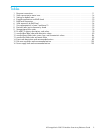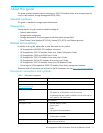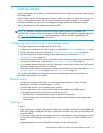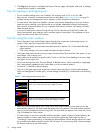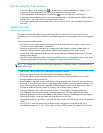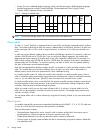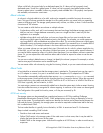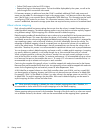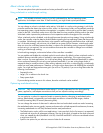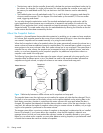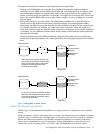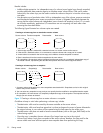
16 Getting started
• Locale. The user’s preferred display language, which overrides the system’s default display language.
Installed language sets include Chinese-simplified, Chinese-traditional, Dutch, English, French,
German, Italian, Japanese, Korean, and Spanish.
NOTE: To secure the storage system, set a new password for each default user.
About vdisks
A vdisk is a “virtual” disk that is composed of one or more disks, and has the combined capacity of those
disks. The number of disks that a vdisk can contain is determined by its RAID level. All disks in a vdisk must
be the same type (SAS or SATA, small or large form-factor). A maximum of 16 vdisks per controller can
exist.
A vdisk can contain different models of disks, and disks with different capacities. For example, a vdisk can
include a 500-GB disk and a 750-GB disk. If you mix disks with different capacities, the smallest disk
determines the logical capacity of all other disks in the vdisk, regardless of RAID level. For example, if a
RAID-0 vdisk contains one 500-GB disk and four 750-GB disks, the capacity of the vdisk is equivalent to
approximately five 500-GB disks. To maximize capacity, use disks of similar size. For greatest reliability,
use disks of the same size and rotational speed.
Each disk has metadata that identifies whether the disk is a member of a vdisk, and other members of that
vdisk. This enables disks to be moved to different slots in a system; an entire vdisk to be moved to a
different system; and a vdisk to be quarantined if a disk is detected missing.
In a single-controller system, all vdisks are owned by that controller. In a dual-controller system, when a
vdisk is created the system automatically assigns the owner to balance the number of vdisks each controller
owns; or, you can select the owner. Typically it does not matter which controller owns a vdisk.
In a dual-controller system, when a controller fails, the partner controller assumes temporary ownership of
the failed controller's vdisks and resources. If the system uses a fault-tolerant cabling configuration, both
controllers' LUNs become accessible through the partner.
When you create a vdisk you can also create volumes within it. A volume is a logical subdivision of a
vdisk, and can be mapped to controller host ports for access by hosts. The storage system presents only
volumes, not vdisks, to hosts.
You can create vdisks with or without volumes by using the Provisioning Wizard, or you can create vdisks
manually.
About spares
A controller automatically reconstructs a redundant (fault-tolerant) vdisk (RAID 1, 3, 5, 6, 10, 50) when one
or more of its disks fails and a properly sized spare disk is available.
There are three types of spares:
• Dedicated spare. Reserved for use by a specific vdisk to replace a failed disk. Most secure way to
provide spares for vdisks but expensive to reserve a spare for each vdisk.
• Global spare. Reserved for use by any redundant vdisk to replace a failed disk.
• Dynamic spare. A properly sized available disk that is automatically assigned to replace a failed disk
in a redundant vdisk.
Table 3 Settings for default users
Name Password Level Type WBI CLI FTP Base Prec. Units Temp. Auto
Sign
Out
Locale
monitor !monitor Monitor Standard Yes Yes No 10 1 Auto
Celsius
30
Min.
English
manage !manage Manage Yes Yes Yes
ftp !flash Manage No No Yes




